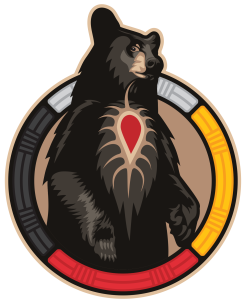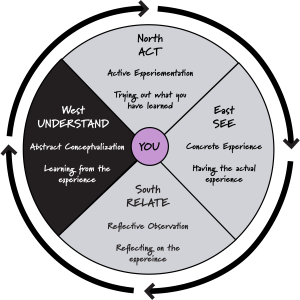
In Connection 5, you will learn about the determinants of Indigenous peoples’ health.
The West: Understanding Theory behind the Experience
In the West, you will learn and understand Connections 5 through 8 as existing models of Indigenous health and wellness. You will also learn from the Indigenous lens through Indigenous storytelling. There are several Checkpoint exercises to test your knowledge along the way.

Why Indigenous Health Perspectives are Needed
Indigenous peoples view health and wellness from a wholistic perspective. Wholistic means considering the physical, spiritual, emotional, and mental dimensions of a person as well as connectedness to land, family, community, nation, and all of creation. Siloed approaches do not address interconnectedness nor do they address the complexity of Indigenous realities (Reading & Wien, 2009).
Beyond the Social: Chapter 1
In a promotional interview (NCCIH, 2016) [3:07] for her book Beyond the Social, Indigenous scholar Charlotte Loppie discusses the determinants of Indigenous peoples’ health using the metaphor of a tree. Watch Dr. Loppie explaining the Structural Determinants of Aboriginal Peoples’ Health in this video. After viewing the clip, return to the micro-credential page by closing the tab.
Click to Watch Beyond the Social [Video]![]()
Key Messages From the Video
- In the tree metaphor, three components – the roots, the trunk, and the crown – are interconnected and work together to create a system of Indigenous realities.
- The Roots create structure for the tree and are referred to as the distal determinants of health. The distal determinants create structure for the systems and environments that influence Indigenous health. Political, economic, social, and historical roots systems influence health and feed into the trunk (Reading, 2015).
- The Trunk is fed by the roots and represent the intermediate determinants of health. Intermediate determinants are represented by systems in the trunk. Trunk systems can include relationships, systems of care and support, and how Indigenous peoples are characterized and treated within these systems (Reading, 2015).
- The Crown is fed by both the roots and the trunk and represents the proximal determinants of health. The proximal determinants of health create the living environments for Indigenous peoples such as poverty vs. affluence, and access to services (Reading, 2015).
Breaking Down the Metaphor of the Tree
In the following section, we will use Dr. Charlotte Loppie’s tree metaphor (NCCIH, 2016; Reading, 2015; Reading & Wien, 2009) to understand the determinants by breaking down each component with some examples.
 Image Description: Structural Determinants of Indigenous Peoples’ Health [Doc]
Image Description: Structural Determinants of Indigenous Peoples’ Health [Doc]![]()
Checkpoint 12: Distal Determinants
Checkpoint 13: Intermediate Determinants
Checkpoint 14: Proximal Determinants
Checkpoint 15: Quiz Time!
Consider what you have learned in Connection 5, then complete this Multiple Choice Quiz.
Strength, Wellness, and Resilience
Carefully read the following quotes before moving on to Checkpoint 16.
“In spite of the considerable health issues and challenges outlined above, [Indigenous] peoples continue to demonstrate resilience and strive for wellness based in Indigenous ways of knowing and being (NCCIH, 2013).”
“Approaches to health care are often rooted in a holistic conception of well-being involving a healthy balance of four elements or aspects of wellness: physical, emotional, mental and spiritual (NCCIH, 2013).”
Checkpoint 16: Strength, Wellness, and Resilience
Connection 5 Summary
In Connection 5, we learned:
- There are gaps in health between Indigenous and non-Indigenous peoples.
- These gaps exist for a whole host of reasons and are called determinants of health.
- There are 3 levels of determinants for Indigenous health; distal determinants create the structure for systems and environments that influence Indigenous health; the intermediate determinants are systems of care and can include relationships and treatment within those systems; proximal determinants are the visible impacts of physical, emotional, mental and spiritual health.
- Despite these gaps in determinants of health, Indigenous peoples have demonstrated strength and resilience by leaning on their own systems of knowledge for healing.

To move on to Connection 6, click on the “Next: Connection 6: Defining Wellness from a First Nation Perspective →” button at the bottom right hand corner of this page.
References
Allan, B. & Smylie, J. (2015). First Peoples, second class treatment: The role of racism in the health and well-being of Indigenous peoples in Canada. Wellesley Institute. https://www.wellesleyinstitute.com/wp-content/uploads/2015/02/Report-First-Peoples-Second-Class-Treatment-Final.pdf![]()
Government of Canada. (2022). Reducing the number of Indigenous children in care. https://www.sac-isc.gc.ca/eng/1541187352297/1541187392851![]()
Indigenous Watchdog. (n.d.). Health(18-24). Retrieved September 29, 2022, from https://www.indigenouswatchdog.org/subcategory/health/![]()
NCCIH. (2016). Beyond the social: Chapter 1 with Charlotte Loppie [Video]. https://vimeo.com/196659680![]()
NCCIH. (2013). An Overview of Aboriginal Health in Canada. National Collaborating Centre for Indigenous Health. https://www.nccih.ca/495/An_Overview_of_Aboriginal_Health_in_Canada.nccih?id=101![]()
Reading, C. (2015). Structural determinants of Aboriginal Peoples’ health. In M. Greenwood, S. de Leeuw, N.M. Lindsay, & C. Reading (Eds.), Determinants of Indigenous Peoples’ health in Canada: Beyond the social (pp. 3-15). Canadian Scholars’ Press.
Reading, C.L., & Wien, F. (2009). Health inequalities and social determinants of Aboriginal Peoples’ health.National Collaborating Centre for Aboriginal Health. https://www.ccnsa-nccah.ca/docs/determinants/RPT-HealthInequalities-Reading-Wien-EN.pdf![]()
Statistics Canada & Indigenous Services Canada. (2019). Report on trends in First Nation communities, 1981 to 2016. https://www.sac-isc.gc.ca/DAM/DAM-ISC-SAC/DAM-STSCRD/STAGING/texte-text/report-trends-FN-Comm-1981-2016_1578933771435_eng.pdf![]()
The National Indigenous Economic Development Board. (2019). The Indigenous economic progress report 2019. http://www.naedb-cndea.com/wp-content/uploads/2019/06/NIEDB-2019-Indigenous-Economic-Progress-Report.pdf![]()
The Royal Canadian Geographical Society, National Centre for Truth and Reconciliation, Assembly of First Nations, Inuit Tapiriit Kanatami, Métis National Council & Indspire. (2018). Canadian Geographic Indigenous Peoples atlas of Canada (Indigenous Canada). The Royal Canadian Geographical Society.

